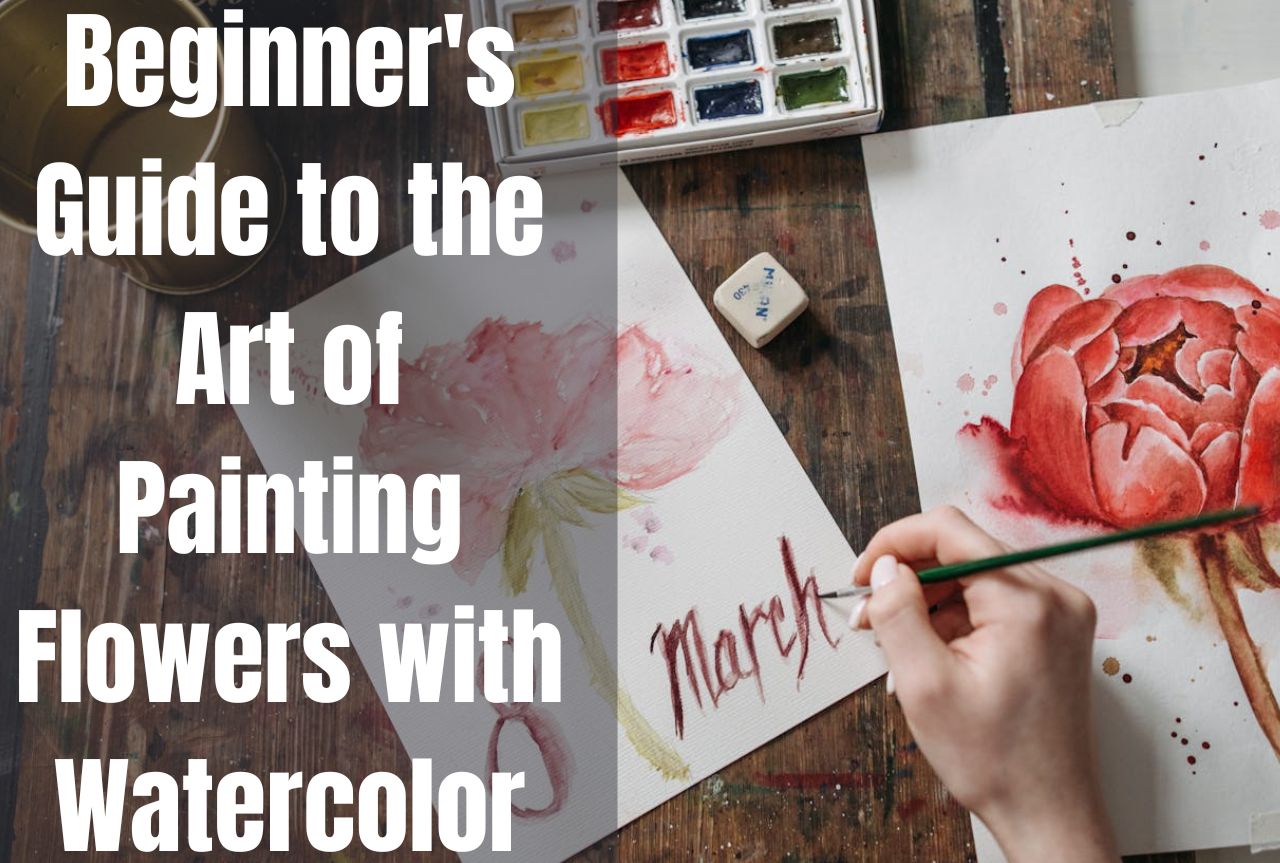Watercolor painting is a type of art that has fascinated artists and audiences for millennia. Its ethereal nature and translucence create a unique medium for expressing the delicate beauty of flowers. Painting Flowers in Watercolor depicts the physical appearance of blooms and conveys their transient and temporary nature.
Understanding Watercolor Materials
Before you begin learning watercolor painting techniques, you must become acquainted with the required materials. The materials you use can greatly impact how your artwork turns out.
Types of Watercolor Paints: Tubes vs. Pans
Watercolor paints come in two varieties: tubes and pans.
- Tubes hold liquid paint and are ideal for mixing big amounts of paint. They are preferred when working on larger items or when a bright, opaque application is required.
- In contrast, pans are little cakes of dried paint. They are small, making them ideal for artists on the move. Pans are ideal for delicate washes and light applications.
Selection of Watercolor Brushes
The brushes you use can have a major impact on your painting approach. Here are some things to consider:
- Size: Larger brushes are best for washes and wide strokes, while smaller brushes are better for details.
- Shape: Round brushes are versatile, flat brushes are ideal for creating bold, straight lines, and filbert brushes combine the two.
- Material: Natural hair, synthetic fibers, or a combination can be used to make brushes. Natural hair brushes may carry more water and paint than synthetic brushes, which are more durable and inexpensive.
Choosing the Right Watercolor Paper
Watercolor paper is another important component. It comes in a variety of textures and weights.
- Hot-pressed paper is smooth and suitable for detailed work.
- Cold-pressed paper offers a medium texture that is ideal for most watercolor applications.
- Rough paper has a distinct texture, ideal for producing unique surface effects.
The weight of the paper is also crucial. Heavier paper may absorb more water and is less prone to warping.
Setting Up Your Workspace
A well-organized workspace can make painting more fun and productive. Here’s how you prepare your workspace for success:
- Palette: Arrange your colors in the rainbow sequence to make color mixing easier.
- Water Containers: Keep two containers of water on hand—one for cleaning your brushes and one for mixing clean water with your paint.
- Layout: Keep your materials within easy reach, and keep a cloth or paper towel nearby to blot your brush.
Preparing your materials and workspace is essential for a successful watercolor painting session. In the following section, we will look at the fundamental techniques of watercolor painting, which will serve as the foundation for creating your flower creations.
Basic Watercolor Techniques.
Watercolor painting is as much about the medium as the artist’s intentions. Understanding and perfecting basic methods is essential for any watercolor artist, especially when painting something delicate, like flowers.
Mastering Watercolor Techniques
The two fundamental approaches in watercolor painting are wet-on-wet and wet-on-dry.
- Wet-on-wet: This technique includes applying wet paint to a wet surface. It allows colors to flow into one another, resulting in smooth borders and gradients. It’s ideal for creating subtle color changes like those in flower petals.
- Wet-on-dry: Wet paint is applied to dry paper, providing greater control and resulting in sharp, clear edges. This approach is perfect for capturing the complex features of flower structures.
Experimenting with these approaches will help you learn how watercolor behaves and how to manipulate it to create the desired look.
Color Theory for Flower Painting
A fundamental understanding of color theory can significantly improve the vibrancy and realism of your floral paintings.
- Warm and cool colors: Warm colors (reds, oranges, and yellows) bring elements closer together, while cool colors (blues, greens, and purples) create a sense of distance.
- Mixing your colors: Instead of using pre-mixed colors, experiment with your shades to add a personal touch to your flowers.
- Shading and Highlights: Use deeper tints to lend depth to your flowers’ recesses and lighter tones to accent the regions where light naturally shines through.
By mastering these fundamental techniques and knowing color theory, you’ll be well on your way to making beautiful watercolor flowers.
Painting Flowers in Watercolor: The Artistic Process
Moving along with our watercolor voyage, we now get to the heart of the matter: painting the flowers themselves. This part will walk you through the process of creating your flower topics on paper.
Sketching Your Floral Composition
Before putting brush to paper, prepare your composition. Begin with a light pencil sketch of your flowers. Consider the following.
- Place your main flowers in the center or off-center to create a dynamic design.
- Perspective: Determine the angle and viewpoint of your flowers. Will you be looking at them from above, sideways, or below?
- Balance: Make sure your composition combines enormous blooms and little buds or leaves.
Applying the First Washes
The first washes of color establish the tone of your painting. Here’s how you can approach them.
- Light to Dark: Start with the lightest colors and gradually progress to the darkest tones. This offers greater control and depth.
- Washes: Use sweeping strokes to bring color to the flowers and leaves. Keep your colors light; you can always add extra layers afterward.
Adding Details and Depth
Once the initial washes have dried, it is time to add details.
- Petals: Use a fine brush to add veins and shadows to the petals, creating a three-dimensional appearance.
- Leaves: Add details like veins and texture to make the leaves look more lifelike.
- Backdrop: To make your flowers stand out, consider using a backdrop wash or leaving them white.
Advanced Watercolor Flower Techniques
As you develop experience in fundamental techniques, you can use more advanced methods for adding realism and texture to your flowers.
Creating Realistic Textures
Textures may make your flowers come to life. Try the following:
- Sprinkle salt over a damp wash to create a textured look.
- Plastic Wrap: Press plastic wrap across a wet wash and allow it to dry to create unique designs.
Painting Different Types of Flowers
Each flower has its unique qualities. Here are some tips for painting different flowers:
Roses: Notice the spiral arrangement of the petals and the delicate edges.
- Peonies: Layers of rounded petals help capture the bloom’s fullness.
- Daisies: Paint the delicate, slender petals that radiate from the center.
Following these procedures and techniques will allow you to make gorgeous watercolor flowers that are colorful and full of life. Remember to practice and try several approaches to see what works best for you.
Finishing Touches: Evaluate and Protect Your Watercolor Painting
After devoting time and effort to painting flowers in watercolor, the last steps are critical to ensuring that your work is finished and kept.
Evaluating Your Work
Once you have completed painting, take a step back and assess your work. Consider the following.
- Color Balance: Are there any places that require greater brilliance or subtlety?
- Is the composition balanced and appealing to the eye?
- Details: Have you captured the tiny details that make your flowers appear realistic?
It is uncommon to find areas that could use some improvement. Use this as an opportunity to improve your painting.
Protecting and Presenting Your Watercolor Painting
Watercolor paintings are delicate and require special care to preserve their endurance.
- Fixatives: While not typically used in watercolor, a small fixative spray can help protect your painting from dust and moisture.
- Framing: Select a frame that compliments your work, and consider using a mat to keep the painting from touching the glass.
Final Thoughts
Painting Flowers in Watercolor is a gratifying experience that combines the beauty of nature with the allure of watercolor. It takes perseverance, practice, and a willingness to learn from each brushstroke. As you continue your artistic path, remember that each painting is a step closer to mastering this magnificent art form.
FAQs
How can I select the appropriate colors for my watercolor flowers?
Begin by viewing genuine flowers and taking note of the minor variances in colors. Use a color wheel to choose complementary colors for your palette.
What should I do if my watercolor paper warps during painting?
You can avoid warping by extending your paper beforehand or using stronger paper. If warping happens, gently smooth the paper under some books once it has completely dried.
Can watercolor painting be done on normal paper?
Regular paper is unsuitable for watercolor since it cannot take water and is prone to deform or rip. It is preferable to use paper created expressly for watercolor painting.
How can I combine watercolors to create the ideal tint for my flowers?
Try mixing colors on a separate palette or piece of paper. Remember that it is simpler to darken a color than to lighten it, so begin with a lighter shade and gradually add more pigment.
What is the greatest method for adding tiny details to my watercolor flowers?
Use a small, fine-tipped brush to ensure the paint isn’t too runny—practice drawing fine lines and details on scrap paper before adding them to your painting.



